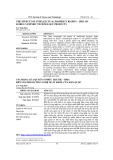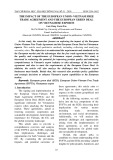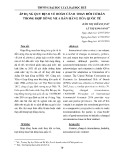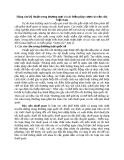
Chapter 9
Application: International Trade
TRUE/FALSE
1. Trade decisions are based on the principle of absolute advantage.
ANS: F DIF: 1 REF: 9-1
NAT: Analytic LOC: Gains from trade, specialization and trade
TOP: Absolute advantage MSC: Interpretive
2. The sum of consumer and producer surplus measures the total benefits that buyers and sellers receive from
participating in a market.
ANS: T DIF: 2 REF: 9-1
NAT: Analytic LOC: Gains from trade, specialization and trade
TOP: Total surplus MSC: Interpretive
3. According to the principle of comparative advantage, all countries can benefit from trading with one another
because trade allows each country to specialize in doing what it does best.
ANS: T DIF: 1 REF: 9-1
NAT: Analytic LOC: Gains from trade, specialization and trade
TOP: Comparative advantage MSC: Interpretive
4. The world price of cotton is the highest price of cotton observed anywhere in the world.
ANS: F DIF: 1 REF: 9-1
NAT: Analytic LOC: Gains from trade, specialization, and trade
TOP: Prices MSC: Definitional
5. If the world price of a good is greater than the domestic price in a country that can engage in international
trade, then that country becomes an importer of that good.
ANS: F DIF: 2 REF: 9-1
NAT: Analytic LOC: Gains from trade, specialization and trade
TOP: International trade | Prices MSC: Interpretive
6. Without free trade, the domestic price of a good must be equal to the world price of a good.
ANS: F DIF: 2 REF: 9-1
NAT: Analytic LOC: Gains from trade, specialization and trade
TOP: Prices MSC: Interpretive
7. The nation of Aviana soon will abandon its no-trade policy and adopt a free-trade policy. If the world price of
goose meat is $3 per pound and the domestic price of goose meat without trade is $2 per pound, then Aviana
should export goose meat.
ANS: T DIF: 2 REF: 9-1
NAT: Analytic LOC: Gains from trade, specialization and trade
TOP: Prices | Comparative advantage | Exports MSC: Interpretive
8. If Argentina exports oranges to the rest of the world, Argentina's producers of oranges are worse off, and
Argentina's consumers of oranges are better off, as a result of trade.
ANS: F DIF: 2 REF: 9-2
NAT: Analytic LOC: Gains from trade, specialization and trade
TOP: Trade | Economic welfare MSC: Applicative
9. If a country’s domestic price of a good is lower than the world price, then that country has a comparative
advantage in producing that good.
ANS: T DIF: 2 REF: 9-2
NAT: Analytic LOC: Gains from trade, specialization and trade
TOP: Comparative advantage | Prices MSC: Interpretive
82

83 Chapter 9 /Application: International Trade
10. When a country allows international trade and becomes an importer of a good, domestic producers of the good
are better off, and domestic consumers of the good are worse off.
ANS: F DIF: 2 REF: 9-2
NAT: Analytic LOC: Gains from trade, specialization, and trade
TOP: Gains from trade MSC: Interpretive
11. If the United Kingdom imports tea cups from other countries, then U.K. producers of tea cups are better off,
and U.K. consumers of tea cups are worse off, as a result of trade.
ANS: F DIF: 2 REF: 9-2
NAT: Analytic LOC: Gains from trade, specialization and trade
TOP: Trade | Economic welfare MSC: Applicative
12. If Belgium exports chocolate to the rest of the world, then Belgian chocolate producers benefit from higher
producer surplus, Belgian chocolate consumers are worse off because of lower consumer surplus, and total
surplus in Belgium increases because of the exports of chocolate.
ANS: T DIF: 2 REF: 9-2
NAT: Analytic LOC: Gains from trade, specialization and trade
TOP: Trade | Economic welfare MSC: Applicative
13. In principle, trade can make a nation better off, because the gains to the winners exceed the losses to the
losers.
ANS: T DIF: 1 REF: 9-2
NAT: Analytic LOC: Gains from trade, specialization and trade
TOP: Trade | Economic welfare MSC: Interpretive
14. Suppose the Ivory Coast, a small country, imports wheat at the world price of $4 per bushel. If the Ivory Coast
imposes a tariff of $1 per bushel on imported wheat, then, other things equal, the price of wheat in Ivory Coast
will increase, but by less than $1.
ANS: F DIF: 2 REF: 9-2
NAT: Analytic LOC: Gains from trade, specialization and trade
TOP: Tariffs | Prices MSC: Interpretive
15. The small-economy assumption is necessary to analyze the gains and losses from international trade.
ANS: F DIF: 1 REF: 9-2
NAT: Analytic LOC: Gains from trade, specialization and trade
TOP: International trade | Assumptions MSC: Interpretive
16. The greater the elasticities of supply and demand, the smaller are the gains from trade.
ANS: F DIF: 3 REF: 9-2
NAT: Analytic LOC: Gains from trade, specialization and trade
TOP: Gains from trade | Price elasticities of demand and supply
MSC: Applicative
17. If a tariff is placed on watches, the price of both domestic and imported watches will rise by the amount of the
tariff.
ANS: T DIF: 2 REF: 9-2
NAT: Analytic LOC: Gains from trade, specialization and trade
TOP: Tariffs | Prices MSC: Interpretive
18. When a government imposes a tariff on a product, the domestic price will equal the world price.
ANS: F DIF: 2 REF: 9-2
NAT: Analytic LOC: Gains from trade, specialization and trade
TOP: Tariffs | Prices MSC: Interpretive
19. A tariff increases the quantity of imports and moves the market farther from its equilibrium without trade.
ANS: F DIF: 2 REF: 9-2
NAT: Analytic LOC: Gains from trade, specialization and trade
TOP: Tariffs | Imports MSC: Applicative

Chapter 9 /Application: International Trade 84
20. When a country abandons no-trade policies in favor of free-trade policies and becomes an importer of steel,
then the domestic price of steel will increase as a result.
ANS: F DIF: 2 REF: 9-2
NAT: Analytic LOC: Gains from trade, specialization, and trade
TOP: Imports | Prices MSC: Interpretive
21. When a country that imports shoes imposes a tariff on shoes, buyers of shoes in that country become worse
off.
ANS: T DIF: 1 REF: 9-2
NAT: Analytic LOC: Gains from trade, specialization, and trade
TOP: Tariffs MSC: Interpretive
22. When a country that imports shoes imposes a tariff on shoes, buyers of shoes in that country become worse off
and sellers of shoes in that country become better off.
ANS: T DIF: 2 REF: 9-2
NAT: Analytic LOC: Gains from trade, specialization, and trade
TOP: Tariffs MSC: Interpretive
23. Deadweight loss measures the decrease in total surplus that results from a tariff or quota.
ANS: T DIF: 2 REF: 9-2
NAT: Analytic LOC: Gains from trade, specialization and trade
TOP: Deadweight losses MSC: Interpretive
24. If a small country imposes a tariff on an imported good, domestic sellers will gain producer surplus, the
government will gain tariff revenue, and domestic consumers will gain consumer surplus.
ANS: F DIF: 2 REF: 9-2
NAT: Analytic LOC: Gains from trade, specialization and trade
TOP: Tariffs | Economic welfare MSC: Applicative
25. Domestic consumers gain and domestic producers lose when the government imposes a tariff on imports.
ANS: F DIF: 2 REF: 9-2
NAT: Analytic LOC: Gains from trade, specialization and trade
TOP: Tariffs MSC: Interpretive
26. The imposition of a tariff on imported wine will increase the domestic price of wine, decrease the quantity of
wine imported, and increase the quantity of wine produced domestically.
ANS: T DIF: 2 REF: 9-2
NAT: Analytic LOC: Gains from trade, specialization and trade
TOP: Prices | Imports | TariffsMSC: Interpretive
27. Suppose that Australia imposes a tariff on imported beef. If the increase in producer surplus is $100 million,
the increase in tariff revenue is $200 million, and the reduction in consumer surplus is $500 million, the
deadweight loss of the tariff is $300 million.
ANS: F DIF: 2 REF: 9-2
NAT: Analytic LOC: Gains from trade, specialization and trade
TOP: Tariffs | Deadweight losses MSC: Applicative
28. Suppose Ecuador imposes a tariff on imported bananas. If the increase in producer surplus is $50 million, the
reduction in consumer surplus is $150 million, and the deadweight loss of the tariff is $30 million, then the
tariff generates $130 million in revenue for the government.
ANS: T DIF: 3 REF: 9-2
NAT: Analytic LOC: Gains from trade, specialization and trade
TOP: Tariffs | Deadweight losses MSC: Applicative

85 Chapter 9 /Application: International Trade
29. Tariffs cause deadweight loss because they move the price of an imported product closer to the equilibrium
without trade, thus reducing the gains from trade.
ANS: T DIF: 2 REF: 9-2
NAT: Analytic LOC: Gains from trade, specialization and trade
TOP: Tariffs | Deadweight losses MSC: Interpretive
30. Import quotas and tariffs both cause the quantity of imports to fall.
ANS: T DIF: 1 REF: 9-2
NAT: Analytic LOC: Gains from trade, specialization and trade
TOP: Tariffs | Import quotas MSC: Interpretive
31. Import quotas and tariffs make domestic sellers better off and domestic buyers worse off.
ANS: T DIF: 2 REF: 9-2
NAT: Analytic LOC: Gains from trade, specialization and trade
TOP: Tariffs | Import quotas | Economic welfare MSC: Interpretive
32. Economists agree that trade ought to be restricted if free trade means that domestic jobs might be lost because
of foreign competition.
ANS: F DIF: 2 REF: 9-3
NAT: Analytic LOC: Gains from trade, specialization and trade
TOP: Trade policy | Employment MSC: Interpretive
33. Free trade causes job losses in industries in which a country does not have a comparative advantage, but it also
causes job gains in industries in which the country has a comparative advantage.
ANS: T DIF: 2 REF: 9-3
NAT: Analytic LOC: Gains from trade, specialization and trade
TOP: Comparative advantage | Employment MSC: Interpretive
34. Most economists support the infant-industry argument because it is so easy to implement in practice.
ANS: F DIF: 1 REF: 9-3
NAT: Analytic LOC: Gains from trade, specialization and trade
TOP: Trade policy MSC: Interpretive
35. If Honduras were to subsidize the production of wool blankets and sell them in Sweden at artificially low
prices, the Swedish economy would be worse off.
ANS: F DIF: 2 REF: 9-3
NAT: Analytic LOC: Gains from trade, specialization and trade
TOP: Trade policy | Economic welfare MSC: Interpretive
36. Policymakers often consider trade restrictions in order to protect domestic producers from foreign competitors.
ANS: T DIF: 1 REF: 9-3
NAT: Analytic LOC: Gains from trade, specialization and trade
TOP: Trade policy MSC: Interpretive
37. GATT is an example of a successful unilateral approach to achieving free trade.
ANS: F DIF: 2 REF: 9-3
NAT: Analytic LOC: Gains from trade, specialization and trade
TOP: GATT MSC: Interpretive
38. NAFTA is an example of a multilateral approach to achieving free trade.
ANS: T DIF: 2 REF: 9-3
NAT: Analytic LOC: Gains from trade, specialization and trade
TOP: NAFTA MSC: Interpretive
39. The rules established under the General Agreement on Tariffs and Trade (GATT) are enforced by an
international body called the World Trade Organization (WTO).
ANS: T DIF: 1 REF: 9-3
NAT: Analytic LOC: Gains from trade, specialization, and trade
TOP: GATT | WTO MSC: Definitional

Chapter 9 /Application: International Trade 86
40. A multilateral approach to free trade has greater potential to increase the gains from trade than a unilateral
approach, because the multilateral approach can reduce trade restrictions abroad as well as at home.
ANS: T DIF: 2 REF: 9-3
NAT: Analytic LOC: Gains from trade, specialization and trade
TOP: Trade policy MSC: Interpretive
41. The results of a 2007 Los Angeles Times poll suggest that a significant majority of Americans believe that free
international trade helps the American economy.
ANS: F DIF: 2 REF: 9-4
NAT: Analytic LOC: Gains from trade, specialization and trade
TOP: Trade policy MSC: Interpretive
42. The results of a 2007 Los Angeles Times poll suggest that the percentage of Americans who believe trade is
harmful to the economy exceeds the percentage of Americans who believe trade is beneficial to the economy.
ANS: T DIF: 2 REF: 9-4
NAT: Analytic LOC: Gains from trade, specialization and trade
TOP: Trade policy MSC: Interpretive
43. Most economists view the United States as an ongoing experiment that raises serious doubts about the virtues
of free trade.
ANS: F DIF: 1 REF: 9-4
NAT: Analytic LOC: Gains from trade, specialization and trade
TOP: Trade policy MSC: Interpretive


























